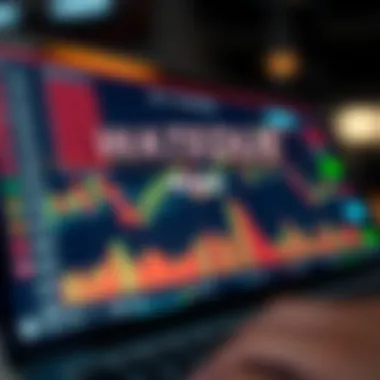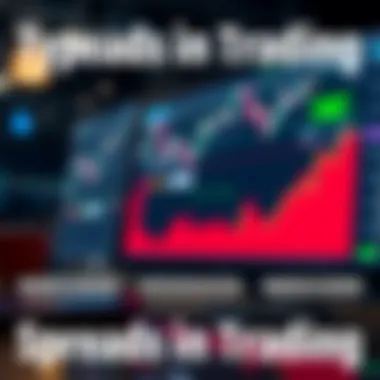Understanding OANDA Broker Spread: A Trader's Guide


Intro
In the world of online trading, understanding the nuances of different platforms can give traders a significant edge. OANDA is often a contender amongst the many brokers out there, and its spread features can greatly influence trading outcomes. So, what exactly is a spread? Essentially, the spread is the difference between the buying and selling price of a currency pair or financial instrument. For traders on OANDA, comprehending this fundamental concept is crucial as it directly affects trading costs and overall profitability. Let's break it down further.
Investment Understanding
Navigating the intricate landscape of investments requires a firm grasp on key terms and concepts. For traders using OANDA, familiarizing oneself with pertinent terminology can lead to more informed decisions and, consequently, better trading performance.
Key Terms Explained
For context, here are some essential terms every trader should have in their toolkit:
- Spread: The gap between the bid price and the ask price. A tighter spread often indicates lower trading costs.
- Pips: The smallest price change that can occur in a trading pair. Understanding pips is crucial for calculating profits and losses.
- Liquidity: This refers to how easily an asset can be bought or sold without affecting its price. High liquidity generally leads to tighter spreads.
- Volatility: The degree of price variation over time. High volatility can lead to wider spreads due to the increased risk.
Having a solid grasp of these terms can demystify the workings of OANDA and similar platforms.
Types of Investments
Traders have a range of financial instruments at their disposal on OANDA. Here’s a look at some of the primary types:
- Forex Trading: This encompasses trading currency pairs such as EUR/USD or GBP/JPY. The foreign exchange market is known for its liquidity and relatively low spreads.
- CFDs (Contracts for Difference): These allow traders to speculate on price changes without owning the underlying asset. Spreads can vary depending on market conditions.
- Commodities: Metals, energy products, and agricultural products can also be traded. Depending on market activity, spreads for commodities may differ significantly.
- Indices: Trading stock indices like the S&P 500 involves spreads that reflect the performance of a group of stocks.
Understanding these investment vehicles is foundational for making strategic choices on the OANDA platform.
Financial Product Insights
Now, let’s delve into the broader aspects of OANDA's offerings.
Comprehensive Reviews
Traders often benefit from assessing broker reviews to gauge the advantages and disadvantages of different trading platforms. OANDA is generally praised for its user-friendly interface and robust educational resources. This makes it convenient for both seasoned traders and novices alike.
However, it’s not without its criticisms. Some users point out that spreads can widen during major market events, which could impact trading strategies. A close examination of OANDA's spread history can provide valuable insights into this aspect.
Comparison of Investment Tools
When comparing OANDA to other brokers, it's vital to consider various features:
- Spread Types: OANDA predominantly uses variable spreads, which can fluctuate based on market conditions. In comparison, fixed spreads remain constant regardless of market activity.
- Trading Costs: Besides spreads, one should take into account other associated costs like commissions and fees. These can significantly affect a trader's net profit.
- Platforms: OANDA’s trading platform is touted for its reliability and efficiency, especially in volatile markets. It also supports various tools for technical analysis, which can aid traders in decision-making.
Key Takeaway: Understanding the factors that affect spreads and overall trading costs is essential for any trader aiming for long-term success with OANDA or any other broker.
Prologue to OANDA
In the complex realm of forex trading, OANDA stands out as a prominent platform not just for its user-friendly interface, but also for its deep liquidity and competitive spread offerings. Understanding OANDA is crucial for traders at all skill levels because it helps illuminate how one’s trading costs can directly impact profitability. The discussion of OANDA lends insights into their trading techniques, and the strategic decisions that traders must navigate in this ever-evolving market.
Overview of OANDA
OANDA Corporation, founded in 1996, is a pioneer in online forex trading, providing a wide range of financial instruments. Initially conceived as a platform primarily for currency exchange, it has evolved into a robust trading environment for investors. With its headquarters in New York and offices across various other locations, OANDA caters to a global clientele. The platform combines advanced trading tools with access to comprehensive data and analytics. It has gained recognition for innovative features such as its historical currency converter and mobile trading capabilities.
OANDA’s appeal lies in its no-dealing-desk model. This approach allows for a more transparent trading experience. By connecting traders directly to interbank liquidity, OANDA reduces the chances of price manipulation. Traders benefit from direct access to the foreign exchange market, and they can execute trades in real-time. The spreads offered by OANDA can vary depending on market conditions, which is pivotal for understanding trading costs.
Importance of Spread in Forex Trading
Forex trading spreads are crucial in understanding the overall cost of trading. The spread refers to the difference between the bid and ask prices of a currency pair. It’s essential for traders to comprehend how spreads affect their trading strategies and profitability. A tighter spread indicates lower trading costs, while a wider spread can erode profit margins significantly.
The concept of spread is often likened to buying a product at one price and selling it at another. For instance, if a trader buys euros at 1.1000 and sells them at 1.0950, the spread is 50 pips. This difference is the broker’s compensation for facilitating the trade and provides crucial insight into OANDA’s pricing strategy. The importance of spread cannot be overstated; it affects everything from the strategy a trader adopts to their overall return on investment.


Traders should also consider that spreads can fluctuate based on various factors such as market volatility, time of day, and trading volume. This variability means that understanding spreads should not be a one-time task but rather an ongoing strategy that should adapt to the trader’s unique circumstances. Keeping a close eye on spreads can help traders manage their costs effectively and improve their trading performance.
"A good timer can help capitalise on greater market efficiency, especially when spreads narrow during times of high liquidity."
What is a Spread?
In the realm of forex trading, the concept of spread is of paramount importance. It acts as the bridge connecting the buying and selling price of a currency pair. Without a firm grasp of what a spread entails, traders could find themselves facing unexpected costs that could easily derail their strategies.
Definition of Spread
At its core, a spread represents the difference between the bid and the ask price in the forex market. The bid price is what buyers are willing to pay for a currency pair, while the ask price is the amount sellers are seeking. Therefore, the spread can be thought of as a transaction cost that traders pay when making trades.
For instance, if the bid price for the EUR/USD currency pair is 1.1200 and the ask price is 1.1203, the spread would be 3 pips. Calculating spreads in this way is essential because they directly influence how profitable or costly a trade can become. In simpler terms, the broader the gap between these two prices, the higher the cost to enter and exit a trade, which potentially affects the overall return on investment.
How Spreads Affect Trading Costs
Understanding how spreads impact trading costs is crucial for any investor. When executing a trade, you're not only betting on the price movement of the currency pair but also on minimizing those spread costs. Here’s a couple of ways spreads can weigh heavy on trading expenses:
- Cost of Entry and Exit: Since you must overcome the spread before making any profit, a wider spread means you need a significant price movement to break even. For example, imagine you buy a currency pair at 1.2000, but the spread is 50 pips. The market would need to rise to at least 1.2050 before you start to recoup your initial investment, which complicates short-term trading.
- Impact on Trading Strategies: Traders often strategize around spreads when deciding the best tactics for trading. For instance, those engaging in scalping or high-frequency trading must pay close attention to spreads as even small differences can make a substantial impact on profitability.
Furthermore, spreads can fluctuate based on various factors including liquidity and market volatility. During turbulent market conditions, spreads often widen, leading to elevated trading costs. Conversely, in stable markets, spreads can tighten, providing a more cost-effective trading environment.
Types of Spreads Offered by OANDA
Understanding the types of spreads OANDA offers is crucial for traders aiming to make well-informed decisions. Spreads directly influence trading costs, which consequently affect potential profit margins. As a trader, knowing the different spread types available to you is like holding the key to a door that opens to more effective strategies and risk management.
Fixed Spreads
Characteristics
Fixed spreads are essentially set offsets that do not alter regardless of market conditions. The hallmark of fixed spreads is their predictability, which makes them a desirable choice for many traders. These spreads are especially beneficial during volatile market conditions since they provide a reliable cost structure. OANDA's fixed spreads stay constant, so traders can build plans around them without the anxiety of unexpected changes.
Advantages
One of the key advantages of fixed spreads is that they bring a sense of stability and control to trading. When a trader knows the exact cost of each trade, it allows for better budgeting and risk assessment. You can think of it as having a fixed expense when renting a home, ensuring that budgeting becomes straightforward. Furthermore, fixed spreads can be a good choice for executing strategies that involve multiple transactions, allowing for consistent performance across varying market conditions.
Disadvantages
On the flip side, fixed spreads might not always be the most economical choice. During periods of low market activity, the cost of trading can be higher than variable spreads, which can narrow during these times. Consequently, traders focusing on tighter margins may find themselves at a disadvantage. Additionally, fixed spreads might not provide the flexibility needed during unpredictable market swings.
Variable Spreads
Characteristics
Variable spreads, by contrast, fluctuate based on market demand and supply dynamics. Their behavior can change significantly during various market conditions—contracting during high liquidity and widening when the markets are less active. For traders that thrive on adaptability, variable spreads can provide opportunities not available with fixed spreads. OANDA's variable spreads reflect real-time conditions, offering a reflection of the market's pulse.
Advantages
The primary advantage of variable spreads lies in their potential for lower trading costs during optimal market conditions. When liquidity is high, spreads can tighten, creating favorable trading environments. This feature appeals to day traders or scalpers who often need to execute multiple trades efficiently. Moreover, the variability allows traders to customize their approach based on market conditions, granting a degree of freedom not seen with fixed spreads.
Disadvantages
However, variability also brings unpredictability. Traders may find themselves facing unexpectedly wide spreads during periods of low volatility or major market announcements, thus increasing costs at inopportune moments. This unpredictability could disrupt a trader's carefully crafted strategy, leading to a less desirable risk-reward profile. Therefore, while variable spreads can be advantageous in active markets, they require a trader to be both vigilant and adaptable.
In essence, whether choosing fixed or variable spreads, understanding their characteristics, advantages, and disadvantages is fundamental to structuring effective trading strategies.
Factors Influencing OANDA's Spread Rates
Understanding what impacts OANDA’s spread rates can provide traders with an upper hand. This section breaks down crucial elements that come into play when determining spreads, shedding light on both opportunities and challenges faced by investors. Each of these factors operates like a cog in the vast machine of forex trading, influencing the overall trading landscape.


Market Conditions
Market conditions can shift like the wind. Economic news releases, geopolitical events, and changes in fiscal policy can all create volatility. When events unfold that lead to uncertainty, traders get jumpy, and this can widen the spread. On the flip side, during stable economic periods, the spreads might be tighter. This sensitivity to market conditions means traders need to stay informed. Getting ahead with knowledge about upcoming releases or shifts can enhance one’s trading strategy significantly.
- Economic Data Releases: Key indicators such as employment figures, inflation rates, or GDP growth can greatly influence spreads as traders react to what these numbers mean for the economy.
- Geopolitical Tensions: Events like elections, trade negotiations, or military actions can create uncertainty, prompting widening spreads.
Time of Day
The time of day holds its own sway over spread rates. Forex trading wraps around the clock, but not all hours are created equally in terms of activity. The forex market is known for its high liquidity during specific windows, such as when major markets overlap.
For instance, the time between the London and New York trading sessions is often marked by heightened trading activity, resulting in tighter spreads. Conversely, during off-peak hours, spreads can inflate as trading volume diminishes.
- Market Overlaps: The London and New York session overlap usually sees a spike in liquidity.
- Off-Peak Hours: Trading outside of these prime times often leads to wider spreads due to lower participant numbers.
Asset Volatility
Different currencies react differently to market stimuli. The more volatile an asset is, the more responsive it is to news and macroeconomic shifts. Highly volatile pairs like the GBP/JPY can see spreads widen sharply in response to shifting investor sentiment or economic reports. On the other hand, more stable pairs typically maintain tighter spreads.
- Currency Pair Selection: Some pairs are infamous for their swinginess, while others remain calm. Understanding these nuances can help in selecting trades wisely.
- Responsive to News: Pairs sensitive to economic data will likely experience changes in spread around news events, impacting trading strategies.
Understanding these influences helps traders to better plan their strategies, minimizing costs while maximizing profitability.
Taking into account these factors that influence OANDA’s spread rates allows for more informed decisions when trading. Knowledge of market conditions, timing, and volatility prepares traders to navigate the complexities of the forex arena.
Comparing OANDA's Spread with Competitors
When it comes to trading in the foreign exchange market, the spread is a crucial factor that can significantly impact a trader's overall profitability. Understanding how OANDA's spread stacks up against competitors provides valuable insight for anyone considering different trading platforms. Comparing OANDA's spread with others helps traders make informed decisions based on costs, service quality, and how the specific trading environment can affect their financial outcomes. This section dives deep into the relevant aspects of spread rates to give you a clearer picture of where OANDA stands among its peers.
Industry Average Spread Rates
Just jumpin' in, let’s take a gander at the industry average spread rates to get our bearings. Generally, the spreads offered by brokers can fluctuate significantly based on market conditions, the currency pairs involved, and the broker's own pricing model. Here's a breakdown of typical average spreads across various brokers:
- Major Currency Pairs: Generally, spreads on pairs like EUR/USD hover around 1-2 pips for most brokers.
- Minor Currency Pairs: For less popular pairs, spreads often widen to 2-4 pips.
- Exotic Pairs: These can be quite costly, with spreads ranging anywhere from 4-10 pips or even more.
When looking at OANDA, their spreads can be competitive but are also subject to market conditions. It’s important to always refer to recent data as spreads can change in real-time. Traders need to be aware of the fact that even minor variances in spread rates can lead to significant cost differences over time, especially if they are trading large volumes.
Advantages of OANDA's Spread Structure
OANDA's spread structure comes with several key advantages that make it a notable option in the trading landscape. Here are some reasons traders might find OANDA appealing:
- Transparency: OANDA prides itself on offering clear and transparent spreads that are easy to understand. No hidden fees or curveballs here.
- Competitive Rates: Their spreads are often lower than several competitors, especially when factoring in overall service quality and execution time. This efficiency can save money for active traders.
- Dynamic Spread Adjustment: As market volatility increases, OANDA adjusts its spreads appropriately. This means that as market conditions shift, traders are not left grappling with unexpectedly inflated costs.
- Access to Advanced Trading Tools: Traders using OANDA benefit from robust trading platforms that provide valuable analytics and real-time data, assisting them in making informed decisions about when to trade and how to manage their positions effectively.
In summary, while many brokers offer similar capabilities, OANDA's emphasis on transparency and competitive rates makes it a strong contender for traders looking for reliable spread options. Observing how their spreads compare against competitors can empower traders to select a platform best suited to their strategies and financial goals.
In the world of trading, knowledge is power. Understanding the spreads that different brokers offer is a step towards mastering costs and maximizing profitability.
For further information on spreads and to stay updated on the current landscape, you might find Investopedia and Forex Factory helpful.
Strategies to Minimize Spread Impact
The spread, often viewed as a hidden cost in trading, plays a crucial role in a trader's bottom line. When dealing with OANDA or any other broker, recognizing how to manage these spreads can enhance profitability. The objective here is not just to be aware of the spreads but to strategically navigate around them to minimize their impact. Taking the right steps can lead traders to maintain a tighter grip on their expenses, enabling better decision-making and ultimately, improved trading outcomes.
Choosing the Right Time to Trade
Timing can make all the difference when it comes to spreads. Forex markets operate around the clock, but that doesn't mean you should trade any time you please. Certain periods can lead to tighter spreads. For instance, trading during major market hours, such as when both London and New York are active, commonly sees lower spreads due to heightened liquidity. This is when traders and institutional investors are making their moves—the competition increases and so does the volume, which generally tightens the spread.
- Understand the Main Trading Sessions:
- Tokyo Session – Generally quieter, known for wider spreads on some pairs.
- London Session – The most active, often has narrow spreads.
- New York Session – Also active, can overlap with London, offering tighter spreads.


By staying informed about the trading hours and potential news releases that might affect market movements, traders can choose the right moment to enter and exit trades. Understanding this calendar can save traders a buck or two, making it an essential strategy.
Utilizing Limit Orders
Limit orders are like your safety net in the volatile world of trading. Instead of jumping haphazardly into the market or accepting the current price—which might be widening the spread at that moment—traders can set a limit order to buy or sell at a specific price. This method allows for better control over the trade execution price.
There are several advantages to employing limit orders to minimize spread impact:
- Pre-set Prices: Traders can predetermine the price they are willing to trade at, avoiding expansive spreads during sudden market movements.
- Improved Trading Discipline: This helps in maintaining a strategy without being swayed by fleeting emotions based on current price changes.
- Reduced Market Impact: When you use limit orders in a liquid market, it can result in your order being filled at a more favorable price, hence potentially minimizing the spread.
To make the most of limit orders, it’s important to assess market conditions and select points with optimal potential for filling your trades without incurring excessive costs:
- Assess Historical Spread Data: Check past spreads of the currency pair you plan to trade. Know how they behave at different times.
- Timing Your Orders: As mentioned earlier, placing orders during known active trading times can enhance the chances of execution at a narrower spread.
"The trade you didn't take is often the one that costs you the most."
Navigating the waters of Forex trading requires strategy and foresight. By understanding timing and making use of limit orders, traders can better cope with spreads and ensure their trading efforts aren’t dampened by unnecessary costs. This level of awareness ultimately leads to smarter trading decisions.
The Role of Spread in Decision-Making
The spread, which represents the difference between the buying and selling price of a currency pair, plays a crucial role in a trader's decision-making process. Understanding this metric is essential for determining whether a trade is economically viable or not. Traders often find themselves faced with myriad choices, decisions influenced significantly by the spread. In this section, we'll discuss the allure and pitfalls of spread in trading, especially when navigating OANDA's platform.
Assessing Trade Viability
When evaluating whether to enter a trade, one of the first steps is to calculate the spread. A narrow spread may signal favorable conditions for executing a trade since it reduces the initial cost of entering the market. Conversely, a wider spread can discourage traders from pursuing certain trades, as it eats into potential profits from small price movements. When assessing trade viability, consider the following:
- Market conditions: Different market environments affect spread size. During major events or high volatility, spreads can widen drastically.
- Asset selection: Certain currency pairs, especially those with lower trading volume, might exhibit larger spreads. Traders should prioritize pairs with tighter spreads for efficiency.
- Risk management: Assess whether the anticipated reward outweighs the costs associated with the spread. If a trade requires a significant price movement to compensate for a broad spread, it might be unwise to proceed.
In summary, thorough assessment of the spread can guide traders in making informed decisions that minimize risks and maximize profits.
Long-Term vs. Short-Term Trading Strategies
The effect of the spread varies notably between long-term and short-term trading strategies. Short-term traders, such as scalpers or day traders, are particularly sensitive to spread fluctuations. For them, entering and exiting trades quickly is key, and a tight spread becomes indispensable. The higher frequency of trades leads to accumulated costs if spreads are wide, thereby eroding profits over time.
On the other hand, long-term traders may find that the spread has a different kind of importance. While they are less affected by temporary widening, they still need to factor the spread into their overall cost calculations. Here are some considerations for both strategies:
- Short-Term Trading:
- Long-Term Trading:
- Needs tight spreads to maintain profitability over many trades.
- Must account for frequent entry and exit points which can compound costs.
- Spreads may not affect decisions on a single trade, but should still be monitored as they can affect overall investment returns.
- A strategy with broader spreads needs to anticipate larger price movements to compensate for costs.
Ultimately, understanding how spreads influence different trading styles aids traders in developing tailored strategies that align with their goals.
Remember, never underestimate the impact of spread on your trading outcomes. Knowledge is power, and being informed can make all the difference.
For further reading on spreads and trading strategies, visit Investopedia or check insightful discussions on Reddit.
End
In wrapping up our examination of OANDA's broker spread, it's crucial to underline how central the concept of spread is in the realm of Forex trading. The spread serves as a bridge between buyers and sellers, directly impacting the cost of executing trades. For investors, finance professionals, and students alike, grasping the nuances of spreads can lead to more calculated trading decisions.
Summary of Key Insights
To summarize the pivotal points discussed in this article:
- Understanding Spread: The spread represents the difference between the buying price and selling price of a currency pair. This fundamental concept shapes not only the profitability of trades but also influences when and how traders choose to enter or exit positions.
- Types of Spreads: We explored OANDA’s offerings, highlighting fixed and variable spreads. Each type has its own set of characteristics, advantages, and limitations, affecting traders differently depending on their strategies and market conditions.
- Influencing Factors: Market conditions, asset volatility, and even the time of day play significant roles in determining the spreads that traders will encounter. Knowing these factors helps traders time their activities more effectively.
- Minimizing Impact: Effective strategies such as careful planning around trading times and using limit orders can significantly help traders reduce the costs linked with spreads. This awareness can mean the difference between a profitable trade and a loss.
The intricate relationship between spread and overall trading performance cannot be overstated. Understanding the spread, its types, and the factors influencing it is, therefore, vital for traders aiming to optimize their performance.
Future Outlook for Traders Using OANDA
Looking ahead, traders who engage with OANDA can expect a landscape shaped by technological advancements and evolving market dynamics. As trading platforms continue to refine their algorithms and data processing capacities, spreads may become even more competitive, but this also means volatility could increase.
- Technological Advancements: Expect to see enhanced analytical tools and real-time data feeds that could provide a deeper understanding of spread variations. This will enable traders to act more swiftly and precisely, maximizing potential profits.
- Market Adaptations: As global economic situations fluctuate, the responses from brokers like OANDA will also vary. Traders will need to stay informed about changes, ensuring they adapt their strategies accordingly.
- Educated Decision Making: Emphasizing education will be crucial. OANDA, amongst other platforms, may offer increasingly elaborate resources to help traders stay knowledgeable about market intricacies.







